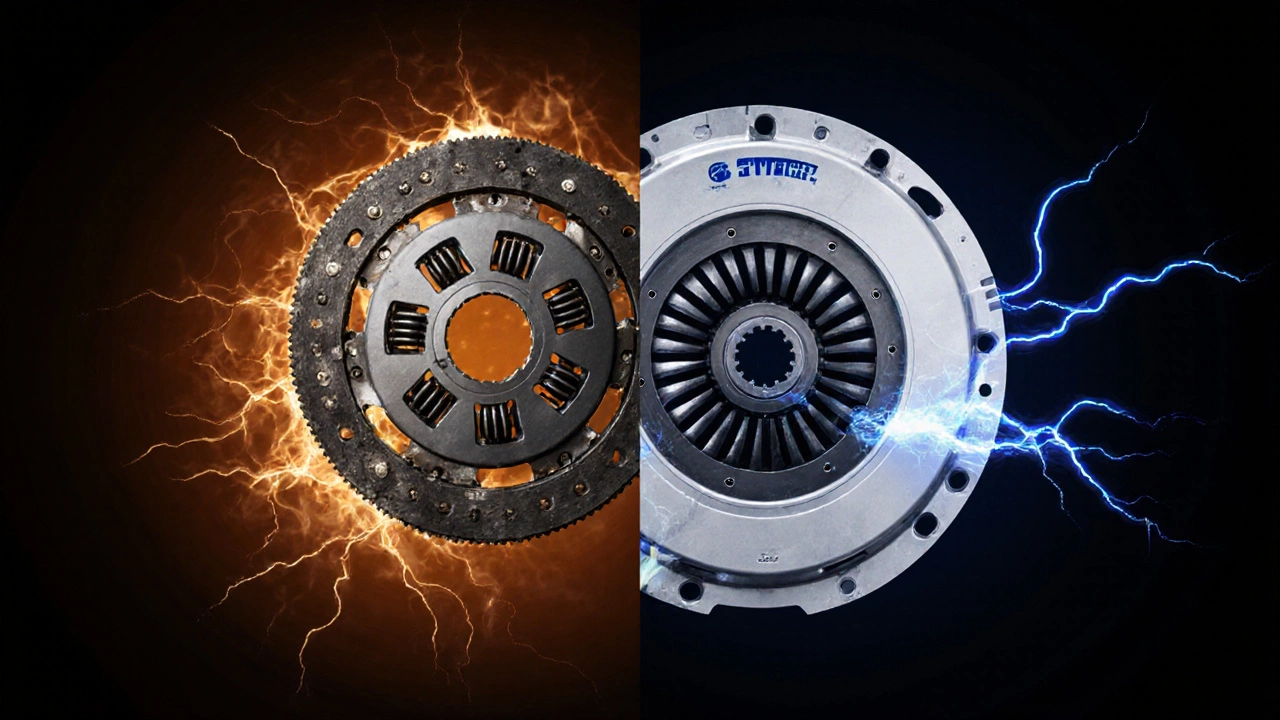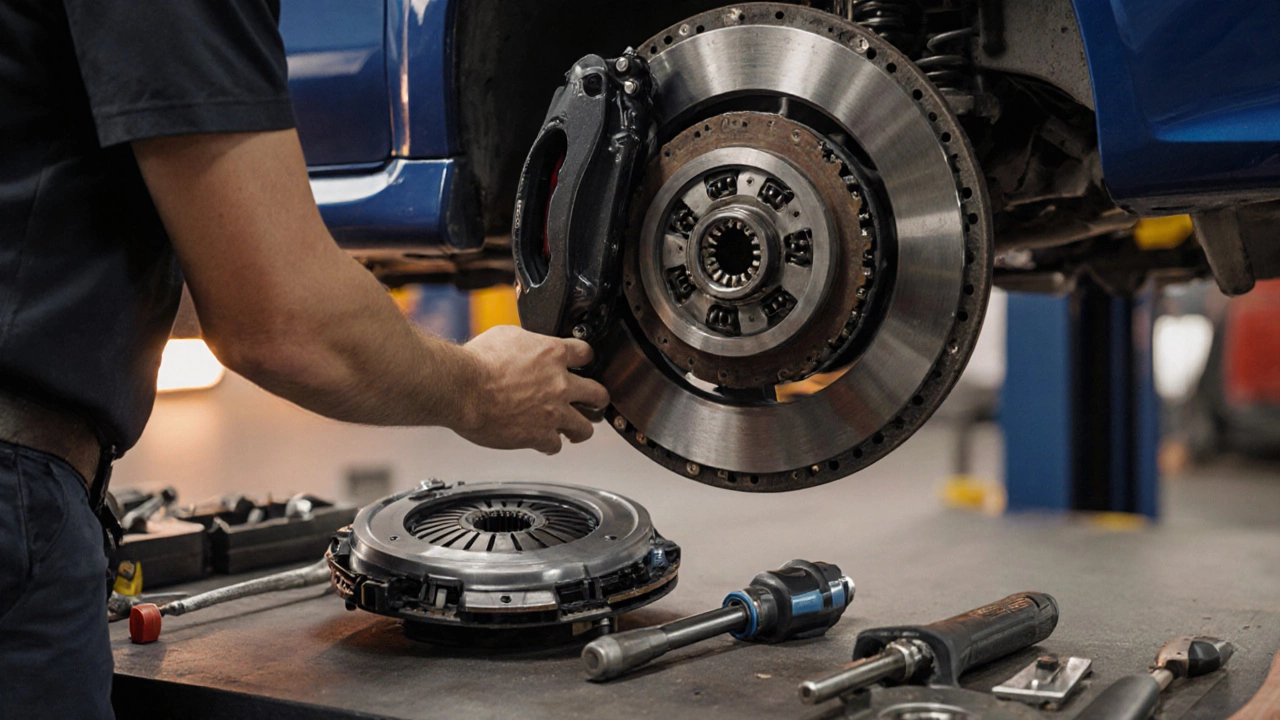Clutch Suitability Calculator
This calculator helps determine if you need a Stage 1 clutch for your vehicle. Enter your current power levels and driving habits to see if your stock clutch can handle the load or if you need a performance upgrade.
Input Your Vehicle Details
Ever heard someone say their car needs a stage 1 clutch and wondered what that actually means? It’s not just a fancy term for a stronger clutch. A stage 1 clutch is a direct upgrade from your factory part-designed to handle more power, last longer, and still drive like a normal car. If you’ve added a tune, a turbo, or just want your manual transmission to feel more responsive, this is where you start.
What Makes a Stage 1 Clutch Different?
Your factory clutch is made for comfort, not performance. It’s soft, quiet, and built to last 80,000-120,000 miles under normal driving. But if you’ve upgraded your engine-even just with a cold air intake and a remap-you’re putting more torque through the drivetrain. That stock clutch starts slipping, overheating, or wearing out fast.
A stage 1 clutch keeps the same pedal feel and engagement as your original, but swaps out the friction material and pressure plate for something tougher. Think of it like upgrading from regular brake pads to performance ones: you still stop smoothly, but now you can handle repeated hard stops without fading.
Most stage 1 kits use a dual-material disc: organic or ceramic compound on the outside for smooth engagement, with a reinforced center for heat resistance. The pressure plate gets stiffer springs to clamp down harder on the disc. That means less slippage under load, but no more juddering or chatter when you pull away from a stop.
Who Needs a Stage 1 Clutch?
You don’t need one if you’re just commuting, towing occasionally, or driving a stock car. But if any of these sound like you, a stage 1 clutch is a smart move:
- You’ve had your car tuned (ECU remap or chip)
- You’ve added a turbocharger or supercharger
- You drive aggressively on back roads or track days
- Your stock clutch is slipping under acceleration
- You’re planning to add more power later
Take a Subaru WRX with a Stage 1 tune. Stock clutch? It’ll start slipping at 3,500 RPM under full throttle. Swap to a stage 1 unit? Now it handles 450 lb-ft of torque without flinching. And you still get smooth take-offs in traffic.
What’s Included in a Stage 1 Clutch Kit?
A full stage 1 clutch kit isn’t just the disc. It’s a complete set designed to work together:
- Clutch disc: Upgraded friction material, often with a sprung hub to reduce vibration
- Pressure plate: Higher clamping force, heat-treated springs, sometimes a lightweight design
- Release bearing: Upgraded to handle higher loads and last longer
- Alignment tool: Ensures the disc is centered during installation
- Hardware kit: New bolts, pilot bearing (if needed), and sometimes a throw-out bearing
Some brands sell just the disc and pressure plate. But if you’re replacing the clutch, it’s smart to replace everything at once. The release bearing wears out over time, and reusing old hardware can cause misalignment or premature failure.

Stage 1 vs Stock vs Stage 2
It helps to see where stage 1 sits on the spectrum:
| Feature | Stock Clutch | Stage 1 Clutch | Stage 2 Clutch |
|---|---|---|---|
| Friction Material | Organic | Organic/Ceramic Hybrid | Multi-Plate Sintered Metal |
| Pedal Feel | Light, smooth | Slightly heavier, still smooth | Firm, grabby, requires more leg strength |
| Torque Capacity | Stock engine output | Up to 40% more than stock | Up to 100%+ more than stock |
| Driveability | Excellent for daily use | Very good for daily use | Poor for stop-and-go traffic |
| Best For | Stock cars, commuters | Tuned cars, spirited drivers | Track cars, drag builds |
Stage 1 is the sweet spot for most people. You get the benefits of a performance clutch without losing daily usability. Stage 2? That’s for race cars or heavily modified street machines. It’s noisy, harsh, and wears out faster. You’ll hate it in rush hour.
What Happens If You Skip the Upgrade?
Ignoring a worn or mismatched clutch doesn’t make the problem go away. It just makes it worse-and more expensive.
Slipping clutch? That means power isn’t reaching the wheels. You’re burning through the friction material faster, overheating the flywheel, and possibly damaging the transmission input shaft. One bad slip under heavy load can warp the flywheel, which means you’ll need a whole new one-costing another £300-£500.
And if you wait until the clutch fails completely? You’re looking at a breakdown on the side of the road. A tow truck. A mechanic’s bill for a full clutch replacement. And you’ll still end up replacing it with a stage 1 unit anyway.
How Long Does a Stage 1 Clutch Last?
It depends on how you drive. If you’re gentle, treat it like a stock clutch, and avoid riding the clutch pedal, you can easily get 60,000-80,000 miles out of it. That’s not as long as a stock clutch, but it’s more than enough for a tuned car.
But if you’re doing frequent launch control, burnouts, or hard launches from a stop? You’ll wear it out faster. Think 30,000-40,000 miles. That’s normal for performance parts. You’re trading longevity for durability under stress.
Most stage 1 kits come with a 12-24 month warranty. That’s a good sign the manufacturer stands behind their product. Avoid no-name brands with no warranty-those are often recycled or poorly made parts.

Installation Tips
Replacing a clutch isn’t hard if you’ve got the right tools and a lift. But it’s not a weekend job for someone who’s never done it. Here’s what you need:
- Jack and jack stands (or a lift)
- Transmission jack
- Clutch alignment tool
- Torque wrench (critical for pressure plate bolts)
- New flywheel bolts (if recommended)
Don’t skip the alignment tool. If the clutch disc isn’t centered, it’ll wear unevenly and cause vibrations or chatter. And always torque the pressure plate bolts in a star pattern-crisscrossing them evenly. Over-tightening cracks the plate. Under-tightening lets it flex and fail.
Also, inspect the flywheel. If it’s glazed, cracked, or worn beyond specs, replace it. A resurfaced flywheel can work-but only if it’s within factory thickness limits. Most shops will check this for you.
Top Brands for Stage 1 Clutches
Not all stage 1 kits are created equal. Here are the brands trusted by mechanics and enthusiasts in the UK:
- Exedy: Reliable, smooth engagement, great for daily drivers with modest power upgrades
- ACT: Known for durability; their Heavy-Duty springs are a step up from stock without being brutal
- Spec: Popular in performance circles; their Stage 1 is often used on tuned Hondas and VWs
- Luk: OEM supplier for many European cars; their performance line is a direct upgrade with OEM-like feel
- King Clutch: UK-based, great support, and kits designed for British driving conditions
Avoid eBay or Amazon listings with no brand name or reviews. A £150 clutch from an unknown seller is a gamble. A £350 kit from Exedy or Luk? That’s an investment.
Final Thoughts
A stage 1 clutch isn’t about going faster. It’s about making sure your car can handle the power you’ve already added. It’s the quiet upgrade that keeps your car reliable, responsive, and safe.
If you’re tuning your car-even just a little-don’t let the clutch be the weak link. A stage 1 unit gives you peace of mind, better performance, and fewer roadside surprises. And for most people, it’s the only clutch upgrade you’ll ever need.

